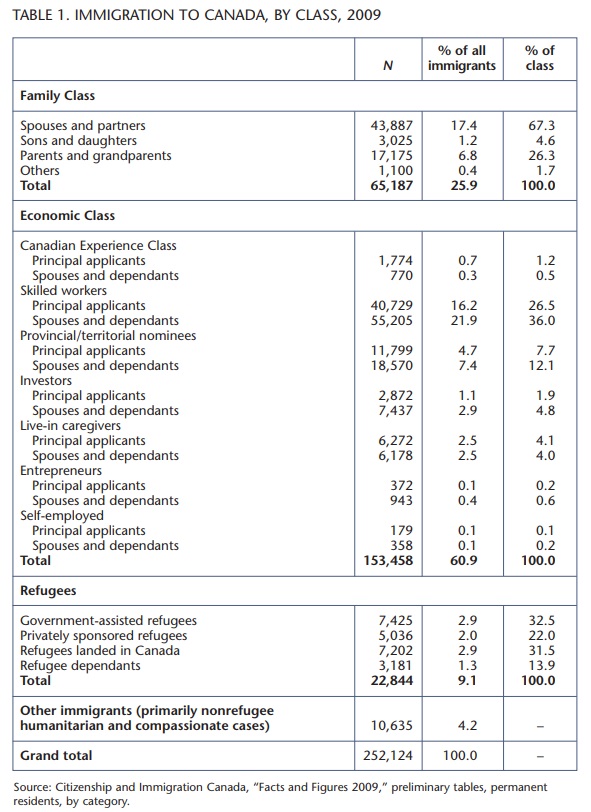
Over the last few decades the substantial decline in labour market outcomes among new immigrants to Canada has become an increasingly pressing issue. Not only have new immigrants’ earnings fallen relative to those of both the Canadian-born and earlier cohorts of immigrants, but poverty rates have increased appreciably.
A number of policy levers have been pulled by Canadian governments in response to this dramatic decline. One of the most recent and potentially major innovations is the introduction by the federal government of a new stream of applicants, the Canadian Experience Class (CEC), within the Economic Class. Although it is broadly similar to decade-old programs in other immigrant-receiving developed countries, especially Australia and New Zealand, it represents a significant departure from Canadian policy and practice since the 1960s.
Introduced only in 2008, this new immigration stream is still minor in importance. Citizenship and Immigration Canada’s preliminary figures (see table 1) indicate that the first 1,774 CEC principal applicants arrived in 2009, together with 770 spouses and dependants, but clearly this number will grow. By comparison, in 2009, 40,729 skilled worker principal applicants were granted permanent residency, together with 55,205 spouses and dependants, a small decline relative to recent years, while the size of the Provincial Nominee Program increased to 30,369 people, from 22,418 in 2008 and 8,047 in 2005. Overall, year-to-year fluctuations were quite modest; the Economic Class in 2009 was a little larger than in the previous three years but slightly smaller than in 2005. There was a similar pattern in total permanent immigration numbers.
The federal government does not appear to intend to increase the size of the Economic Class as the CEC expands, so other elements of that class, in particular the Skilled Worker Program, which is built around the points system and is currently the mainstay of economic immigration, will decrease. Comparing CEC to the Skilled Worker Program is therefore particularly relevant, since these two programs will trade off against each other in achieving immigration policy’s economic goals.
In brief, the CEC is relevant to those who desire to become permanent residents of Canada (and intend to live outside of Quebec, which has its own selection system) and are currently, or were previously, temporary residents. In addition to other criteria, during their temporary stay they must have successfully obtained either of two types of Canadian experience. The second applicant pool is foreign graduates from Canadian post-secondary institutions who have been enrolled for at least two years full time, and have had at least one year of full-time (or equivalent) skilled work experience in Canada after graduation. In both cases, managerial and professional occupations, as well as technical occupations and skilled trades — as defined by the Canadian National Occupational Classification — all qualify. Individuals must have been authorized to work in Canada and, although in some situations no visa is required, it is likely that most workers applying in the first category of the CEC would have had a work visa under the high-skilled temporary foreign worker (TFW) program (which is distinct from less-skilled TFW programs).
The concept of “skilled worker” that is employed by the CEC differs in important dimensions from that employed by the Skilled Worker Program. For the CEC, a skilled worker is one who has actually obtained a skilled occupation in Canada and held it for a certain period of time. In contrast, principal applicants in the Skilled Worker Program are defined under the points system according to certain criteria: education, language ability, age and so on. With respect to the Canadian labour market, therefore, the CEC defines “skilled” retrospectively based on what is effectively a trial run, whereas the Skilled Worker Program defines it prospectively. One important difference is that because technical occupations and skilled trades are accepted in the CEC, workers who would not have obtained sufficient points in the Skilled Worker Program will be admitted through this new stream. Of course, both programs are interested in selecting immigrants who will have future labour market success.
Importantly, this new class substantially enlarges the roles and responsibilities of employers in immigrant selection and integration, and it introduces post-secondary institutions as new players. Some observers may think that this transfer of responsibility will reduce federal administrative costs in selection, but realistically the CEC will increase the relevance of the federal role in verification and enforcement. It remains unclear how well the federal machinery will adapt to this enhanced role. As Australia and New Zealand have done, government must actively monitor for fraud and adjust in response to employers and post-secondary institutions, who “game the system” while operating just inside the rules.
Like other Canadian immigration programs, the CEC handles family immigration by allowing each family to designate a principal applicant who is assessed. If that person is admitted, then his/her spouse or dependants are also admitted. Applicants under the CEC program must also meet the standard health and security checks, and the principal applicant must meet minimum English or French language requirements
The linguistic capacities of CEC and skilled worker applicants are evaluated quite differently. For the latter, language is evaluated by a points system and can represent up to a maximum of 24 points out of a possible 100 (with 67 points being the pass mark). Each applicant designates a first and second official language — the first is eligible for a greater number of points — and obtains points for speaking, listening, reading and writing each language. Although the percentage of all possible points allocated to language is quite high, it is still possible to meet the 67-point cut-off without high marks in either English or French.
In contrast, the CEC allows applicants to present evidence for only one of Canada’s official languages, and those with work experience in occupations classified as high skilled must meet a higher standard than those whose Canadian employment was in technical and trades sectors. Unlike the Skilled Worker Program, the CEC recognizes a relationship between language requirements and the nature of the employment that workers are expected to undertake. This is an extremely important and positive evolution that reflects a large body of evidence pointing to the importance of English and/or French language skills for labour market success. However, immigrants’ average labour market success would improve if the language requirements were strengthened for both immigration classes.
The most prevalent concerns regarding the CEC involve wage or employment competition with the existing Canadian population, which includes both the Canadian-born and previous cohorts of immigrants. Indeed, it is plausible that the CEC will generate larger short-run displacement effects, such as bidding down domestic wages, than does the Skilled Worker Program.
Although most economists believe that the long-run net effect of immigration on the domestic economy is positive but close to zero, it is nevertheless possible that some subgroups might be strongly positively or negatively affected. At issue is not whether immigration increases an economic measure such as national GDP (surely it does), but rather whether it increases GDP per capita (a more debatable issue). In the short run, highly skilled immigrants may decrease the rate of return to that portion of the domestic population most similar to the new immigrants, notably recent immigrants. Research provides some (limited) evidence that highly educated Canadians also experience more wage pressure from immigrant skilled workers than do Canadians more generally.
Importantly, this new class substantially enlarges the roles and responsibilities of employers in immigrant selection and integration, and it introduces post-secondary institutions as new players. Some observers may think that this transfer of responsibility will reduce federal administrative costs in selection, but realistically the CEC will increase the relevance of the federal role in verification and enforcement.
To avoid these negative impacts and ensure per capita economic growth, new immigrants must be complements to, not substitutes for, the existing labour force. We focus on TFWs within the CEC in discussing this, although broadly similar issues also occur for the foreign students. The federal government addresses some of these issues for the TFWs in the CEC in the operation of the high-skilled TFW program from which the CEC draws. In particular, firms are supposed to seek a TFW only if a Canadian resident cannot be found at the going wage. Human Resources and Skills Development Canada (HRSDC) provides a Labour Market Opinion for each position, which is designed to verify this claim and ensure that wages for the TFWs are not below Canadian norms. (Australia had to implement a minimum wage threshold for its CEC equivalent; categorizing occupations correctly is difficult.) This protects the domestic workforce and improves the likelihood that new immigrants are complements in production, thereby generating positive benefits for society. Of course, some argue that it also interferes with normal labour market signals whereby occupational wage increases signal excess demand and stimulate supply. For Canadian workers this is relevant because, as Statistics Canada reported in 2008, after adjusting for inflation the median wages for full-time workers have not changed appreciably in the last quarter century. The result is the median worker is facing stagnant wages, although households may be feeling slightly wealthier because of the increased number of workers in each.
The federal government has revealed by its actions that it does not believe these concerns to be particularly serious, or at least it believes that the benefits to those who gain exceed the costs to those who lose. Recent administrative changes to the TFW program, such as extending visa durations from a maximum of 12 to 24 months, streamlining processing and developing a list of occupations with reduced access barriers, have weakened protection for domestic workers and reduced employer recruitment costs.
Although there has been much research internationally, virtually no evaluation has been conducted about the net impact of immigration to Canada since the 1991 Economic Council of Canada report, which was before NAFTA. While the absence of evidence implies neither success nor failure, the rest of this article will ignore the “fears” presented here, since there is so little evidence. Instead, we will focus on the “hope” side of the story.
The Canadian Experience Class program was designed to address many issues associated with the decline in new immigrants’ labour market outcomes (especially earnings) observed over the last decade, including:
- lack of recognition of pre-immigration human capital (such as education and general labour market experience);
- lack of relevance of pre-immigration human capital in the Canadian context;
- language or literacy gaps that reduce the productivity or transferability of pre-Canadian human capital; and
- lack of complementary knowledge or networks to make immigrant human capital more productive.
TFWs and foreign students accepted through CEC are anticipated to have fewer difficulties with such issues as language, credentials and networks, and they are therefore expected to make the transition into the Canadian labour market more smoothly or quickly than other immigrants.
However, no CEC-stream immigrants have been in the Canadian labour market long enough to enable an evaluation of whether these expectations are realistic. Still, we are able to get some hint of their future labour market success either by looking at current TFWs’ outcomes or by examining CEC-like immigrants’ outcomes (those with pre-immigration temporary foreign work experience or Canadian education).
In his contribution to Canadian Immigration: Economic Evidence for a Dynamic Policy Environment, Casey Warman compared the earnings-based economic rate of return to pre-immigration human capital of recent immigrants and current temporary foreign workers. As expected, recent immigrants had a small negative (close to zero) rate of return to their pre-immigration labour market experience, whereas temporary foreign workers had a positive and sizable rate of return to their work experience. He further observed that both received a positive rate of return to education, but the rate of return for recent immigrants was substantially smaller. Therefore TFWs are better able to obtain recognition for their foreign-acquired human capital. However, it’s not clear who among the existing TFWs would qualify to, or have any interest in, immigrating or, Canada, so while the results are interesting, it is not clear how they would translate for permanent migration.
The most prevalent concerns regarding the CEC involve wage or employment competition with the existing Canadian population, which includes both the Canadian-born and previous cohorts of immigrants. Indeed, it is plausible that the CEC will generate larger short-run displacement effects, such as bidding down domestic wages, than does the Skilled Worker Program.
In a paper for the Canadian Labour Market and Skills Research Network, we used Statistics Canada’s Longitudinal Survey of Immigrants to Canada to create two CEC-like groups of immigrants, former TFWs and former foreign students in Canada, and we examined their weekly earnings four years after landing. We did not differentiate between principal applicants and spouses or dependants, since the system selects entire families; if, by luck or design, one stream attracts highly successful spouses or dependants, that is credited as a benefit to that stream. While it is clear that these immigrants who landed under the pre-CEC system are not perfect proxies for the immigrants who are anticipated under the new program, they give us an indication of what we might expect.
Using a sample that includes all immigrants regardless of their current labour market status, ignoring individual characteristics (since they have already been taken into account by the immigration selection process) and differentiating only by immigration category, we observed that four years after landing, pre-immigration TFWs and foreign students have, on average, appreciably and statistically significantly higher earnings than do those in the skilled worker category. The magnitude of the effect is more than 50 percent. Additionally, skilled workers have the highest earnings of all economic and noneconomic class immigrants, with the exception of provincial nominees, who are statistically indistinguishable.
We also explored employment rates, undertook comparisons with skilled worker principal applicants and other subsamples, looked for differences between males and females, and statistically controlled for alternative sets of observable characteristics. In no case did we observe either of the CEC-like categories having poor average outcomes. We also found that the relative advantage of individuals with Canadian experience is larger for those immigrating from non-Western countries. In short, pre-immigration TFWs and foreign students appear to have higher labour market earnings than those selected into even the highest-earning immigration class.
Although it is not entirely clear how generalizable these results are for the new CEC, the success of these CEC-like immigrants in Canada’s labour market bodes well for the success of CEC immigrants. It seems entirely plausible that the labour market outcomes of CEC immigrants will be at least as good as those of the skilled worker category, and they might be appreciably better. The TFW portion of the selection strategy also increases the probability that migrants will be complements to the local workforce, as opposed to substitutes, in production. But this new class might also result in some negative effects for the Canadian population, and the successful administration of Labour Market Opinions by HRSDC will be crucial in this respect.
Photo: dennizn / Shutterstock










